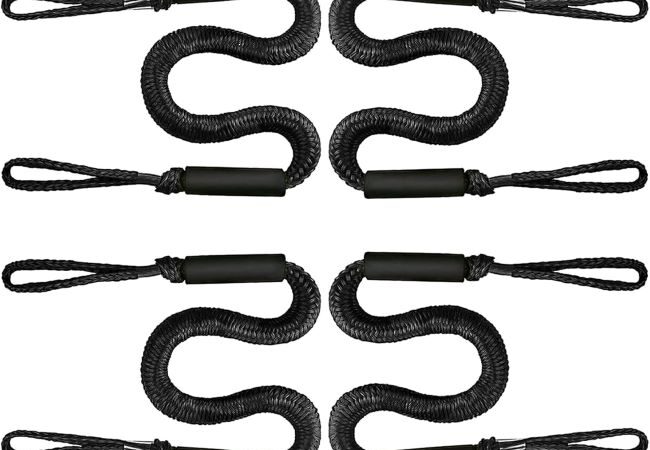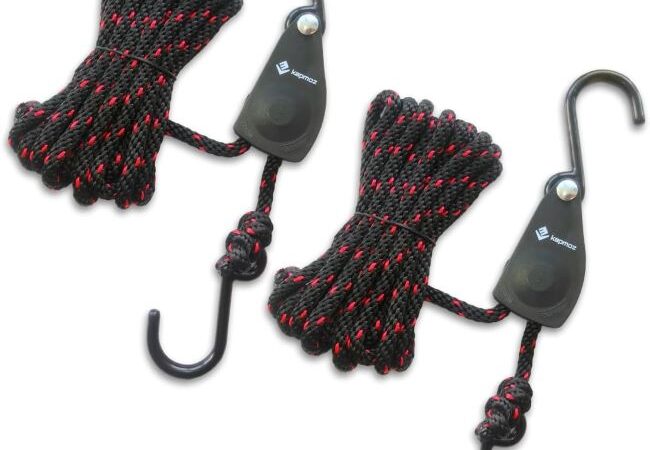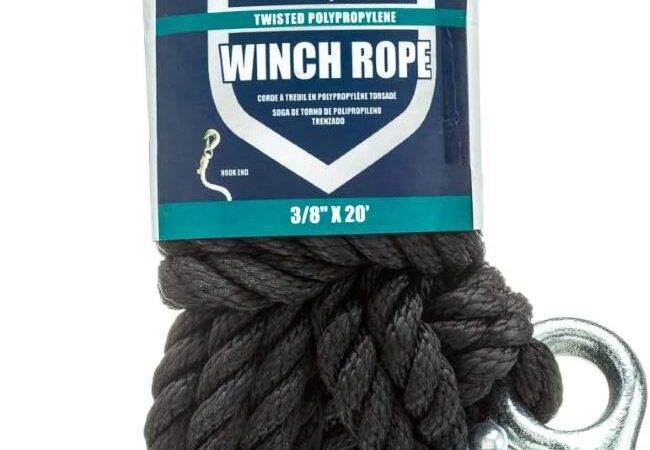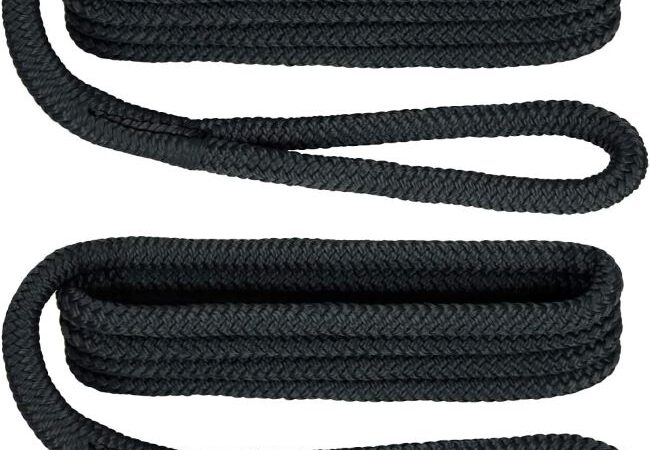
Rope Used for Cutting Down Trees: Essential Gear Guide
Arborists often use a specialized rope, designed for strength and durability, to cut down trees. This rigging rope aids in the safe and controlled removal of tree limbs and trunks.
Contents at a Glance
ToggleCutting down trees, a task known as tree felling, requires precision, skill, and the right equipment. Among the essential tools for arborists and lumberjacks is the rigging rope, a high-tensile cord capable of withstanding heavy loads and friction. Safety is paramount in tree removal, and using a robust rope ensures that large branches and sections of the tree can be carefully guided to the ground.
This method minimizes the risk of uncontrolled falls, which could lead to property damage or personal injury. Selecting the appropriate rope involves considering factors such as the tree’s size, weight, and the surrounding environment. With advancements in technology, modern arborist ropes combine flexibility, strength, and durability, allowing professionals to perform their work effectively while adhering to safety standards.
The Significance Of Rope In Arboriculture
The Significance of Rope in Arboriculture cannot be overstated. Ropes are essential tools for arborists, the skilled climbers who trim, maintain, and remove trees. These professionals rely on high-quality ropes for their daily tasks. Ropes offer support, aid in the control of falling branches, and ensure safety. Choosing the right rope can mean the difference between a job well done and a potential hazard.
Key Roles In Tree Cutting And Removal
Ropes play several vital roles in tree cutting and removal:
- Support for Arborists: Ropes bear the weight of climbers, keeping them secure.
- Controlled Descent: They help in lowering large limbs smoothly to the ground.
- Rigging Operations: Ropes are used to set up complex systems for removing trees.
- Directional Felling: They guide the fall of a tree for precision and safety.
Safety Implications Of Proper Rope Usage
Using ropes correctly is crucial for safety in arboriculture:
| Aspect | Impact |
|---|---|
| Strength and Durability | Ensures that ropes can handle the weight and stress during operations. |
| Proper Handling | Reduces the risk of accidents and rope failure. |
| Regular Inspections | Identifies wear and potential hazards before they cause harm. |
| Correct Rope Type | Matches the specific task needs, from climbing to rigging. |
Correct usage of ropes also protects the arborist and bystanders from falling debris. Professional training is essential to understand how to use ropes safely. This training includes knot tying, rigging techniques, and emergency procedures.
Types Of Rope For Arborist Activities
Understanding the right types of rope for arborist activities is vital. The right rope ensures safety and efficiency when cutting down trees. Arborists use different ropes for climbing and rigging. Each type of rope serves a unique purpose. It must meet specific requirements.
Climbing Ropes: Features And Selection
Arborists choose climbing ropes with great care. They need ropes that are lightweight and flexible. Climbing ropes must also be strong enough to support the climber’s weight. These ropes come with different features:
- Static or dynamic elongation for shock absorption
- Diameter that ensures a good grip
- Sheath construction for durability against rough tree bark
Choosing the right rope involves looking at the tree’s size and the climber’s preference. Safety is the top priority.
Rigging Ropes: Strength And Durability
Rigging tasks demand ropes that can handle heavy loads. These ropes are thicker and stronger than climbing ropes. They have features like:
| Feature | Benefit |
|---|---|
| High tensile strength | Holds up heavy branches safely |
| Resistance to abrasion | Lasts longer against rough surfaces |
| Minimal stretch | Provides control over falling branches |
Arborists select rigging ropes based on the weight of the wood and the distance it needs to move. The right rope ensures the job gets done without damage or injury.
Material Matters: Rope Composition
Material Matters: Rope Composition plays a pivotal role in tree cutting operations. The rope’s material can influence strength, flexibility, and safety. Let’s explore the differences between natural and synthetic fibers and the latest advancements in rope technology.
Natural Fibers Vs. Synthetic Fibers
Choosing the right rope begins with understanding fiber types. Each has unique properties.
| Natural Fibers | Synthetic Fibers |
|---|---|
| Cotton | Polypropylene |
| Sisal | Nylon |
| Manila | Polyester |
- Natural fibers are eco-friendly and have good knot-holding ability.
- Synthetic fibers offer superior strength and resistance to elements.
Advancements In Rope Technology
Modern ropes blend fibers for enhanced performance. These ropes are lightweight and strong.
- Coated fibers resist water and abrasion.
- Composite ropes offer higher breaking strengths.
- Braided structures improve durability.
Today’s ropes are designed for safety and efficiency. They ensure arborists can work confidently.
Rope Specifications And Their Importance
Rope specifications are crucial for safely cutting down trees. The right rope affects efficiency and safety. Here, we discuss key specifications.
Diameter And Length Requirements
Different tree sizes need different ropes. Thicker ropes are stronger. They handle larger, heavier trees. Length is also vital. It ensures the rope reaches from the tree to the pulling point without tension loss. Here are common specs:
- Small trees: 10mm diameter, 30 meters long
- Medium trees: 12mm diameter, 45 meters long
- Large trees: 16mm diameter, 60 meters long
Breaking Strength And Working Load Limit
The rope’s breaking strength and working load limit (WLL) are key for safety. Breaking strength is the maximum force the rope can handle before it fails. WLL is the maximum safe force that should be applied. It is usually a fraction of the breaking strength.
| Rope Type | Breaking Strength | Working Load Limit |
|---|---|---|
| Nylon | 5800 kg | 1200 kg |
| Polyester | 5200 kg | 1100 kg |
| Polypropylene | 2500 kg | 500 kg |
Choosing the correct rope helps manage the load efficiently and ensures everyone’s safety. Always check these specifications before starting work.
Proper Rope Maintenance
Proper rope maintenance is key for safety and longevity. Whether you’re a professional arborist or a homeowner, the ropes used in tree cutting demand care. This care ensures they can withstand the stresses of their critical job. Ignoring maintenance can lead to accidents and equipment failure.
Cleaning And Storage Best Practices
Clean ropes last longer and perform better. Dirt and debris can damage fibers. Follow these best practices:
- Wash ropes using mild soap and cool water.
- Brush off any loose dirt before washing.
- Air dry away from direct sunlight.
- Store in a cool, dry place, free from chemicals.
- Use a rope bag to prevent tangling and protect from pests.
Inspection And Retirement Criteria
Regular inspection ensures ropes remain safe. Look for signs of wear and tear. Use these criteria to decide when to retire a rope:
| Criteria | Action Required |
|---|---|
| Visible core fibers | Retire immediately |
| Discoloration | Inspect for chemical damage |
| Excessive abrasion | Retire if severe |
| Glazed or melted spots | Retire immediately |
Document each inspection. Record the rope’s usage and any damage. Replace ropes according to the manufacturer’s guidelines or when they fail to pass inspection.

Credit: canberradiamondblade.com.au
Knots And Hitches: Securing The Rope
Knots and Hitches: Securing the Rope is a crucial skill for anyone involved in tree cutting. The right knot can mean the difference between a safe operation and a dangerous mishap. Ropes play a vital role in guiding the fall of a tree, supporting limbs, and protecting workers from accidents. A secure knot ensures control and safety, making knowledge of various knots and hitches essential.
Essential Knots For Tree Cutting
Several knots are indispensable in tree cutting. Each serves a specific purpose. Below, find the key knots that every arborist or tree worker should master:
- Bowline Knot – For creating a secure loop that won’t tighten under load.
- Running Bowline – A variation of the bowline, ideal for securing the tree top.
- Double Fisherman’s Knot – Used to join two ropes securely.
- Clove Hitch – Helps to quickly secure a rope to a tree or branch.
- Figure Eight Knot – For a strong stopper knot at the end of a rope.
Each knot has a specific application and knowing when to use which is vital.
The Art Of Tying And Its Impact On Safety
The process of tying knots is an art that directly impacts safety during tree cutting. A well-tied knot provides stability and confidence to the crew members. Here’s how the art of tying ensures safety:
| Knot Type | Function | Safety Benefit |
|---|---|---|
| Bowline Knot | Creates a fixed loop | Won’t slip under tension, ensuring the climber’s safety |
| Clove Hitch | Attaches rope to an object | Easy to adjust, providing quick securement and release |
| Double Fisherman’s Knot | Joins two ropes | Strong connection prevents rope failure |
Proper knot tying is not just a skill, it’s a safety protocol. Each knot must be tied with precision to prevent accidents and ensure the tree falls in the intended direction.
Rope Handling Techniques
Rope Handling Techniques are vital for safe and efficient tree cutting. Proper use of ropes can protect the arborist and ensure the tree falls in the right direction.
Climbing Strategies For Arborists
Climbing trees requires skill and the right approach. Arborists use specific climbing techniques to ascend safely:
- Single Rope Technique (SRT): This method uses one rope fixed at a high point. It offers a direct route up the tree.
- Double Rope Technique (DRT): Involves two ropes, providing stability and flexibility during the climb.
Arborists must always check their gear before climbing. They ensure knots are tight and carabiners are locked.
Rigging Methods For Tree Removal
Rigging is crucial for controlling how large tree sections descend. Here are key techniques:
- Lowering: Uses ropes to guide the descent of cut branches to avoid damage.
- Speed Line: Moves branches quickly away from the tree to the drop zone.
Each technique requires precise setup. Ropes are anchored securely, and pulleys are used to manage the load.
Proper rope handling ensures safety and efficiency in tree removal tasks. Arborists follow these strategies to manage risks and protect property.
Credit: m.petzl.com
Safety Gear And Accessories
Safety gear and accessories play a crucial role in the process of cutting down trees. Professionals use specialized equipment to ensure they can perform their tasks safely and efficiently. This equipment includes harnesses, ascenders, pulleys, and carabiners, each serving a unique function in the tree cutting process.
Harnesses And Ascenders: Climbing Aids
When scaling trees, climbers must rely on durable and secure equipment.
- Harnesses wrap around a climber’s body. They provide support and safety high above the ground.
- Ascenders help climbers move up the rope smoothly. They lock in place to prevent slipping.
Both pieces are essential for climbers to reach the necessary heights safely.
Pulleys And Carabiners: Enhancing Rigging Efficiency
Pulleys and carabiners are key to managing the ropes used during tree cutting.
| Pulley | Carabiner |
|---|---|
| Reduces the effort needed to lift heavy branches. | Connects various rigging components securely. |
| Guides the rope to avoid tangling and friction. | Quick to attach and detach for fast adjustments. |
Together, these tools increase the efficiency and safety of the rigging system.
Case Studies: Rope In Action
Exploring the role of rope in tree cutting reveals a wealth of knowledge. Case studies highlight rope’s critical function in both successful operations and learning from mishaps. Let’s delve into real-world examples underlining the importance of rope in arboriculture.
Success Stories In Tree Cutting
Arborists rely on high-quality ropes for safe and efficient tree removal. Highlighted below are instances where the right rope made a difference:
- Massive Oak Removal: A team used a 1/2-inch static rope to rig down a 200-year-old oak. This rope held up against immense loads, ensuring a safe, controlled descent of heavy limbs.
- Urban Tree Extraction: In a tight space, a braided rope provided the precision required to navigate obstacles. The tree came down without incident, protecting nearby structures.
Lessons Learned From Arborist Accidents
Mistakes and accidents offer valuable lessons. Here are key takeaways from rope-related incidents:
| Incident | Lesson |
|---|---|
| Rope Snap: A worn rope broke under stress, causing injury. | Regular rope inspection and replacement are crucial for safety. |
| Incorrect Knot: A knot failed, leading to a fall. | Proper knot-tying skills are essential. Training can prevent failures. |
Rope quality, maintenance, and handling knowledge are vital for avoiding accidents. These stories remind us to prioritize safety in every tree-cutting task.

Credit: chainsawacademy.husqvarna.com
Choosing The Right Rope: A Buyer’s Guide
Welcome to the ‘Choosing the Right Rope: A Buyer’s Guide’. The right rope is crucial for safely cutting down trees. This guide will help you pick the best one for your needs.
Factors To Consider When Purchasing
Before you buy a rope, think about these points:
- Material: Ropes can be made from nylon, polyester, or polypropylene. Nylon stretches, absorbing shock. Polyester is less stretchy, more weather-resistant. Polypropylene is lightweight and floats on water.
- Diameter: Thicker ropes are stronger but heavier. Choose a diameter that balances strength with ease of use.
- Length: Make sure the rope is long enough for your tree-cutting tasks.
- Load capacity: The rope must handle the weight of the tree sections being removed. Check the breaking strength and working load limit.
- Flexibility: A more flexible rope is easier to knot but might be less durable.
- UV resistance: Sunlight can weaken ropes over time. UV-resistant ropes last longer outdoors.
- Abrasion resistance: Ropes used around rough bark need to resist wear and tear.
Recommended Brands And Products
Top picks for tree-cutting ropes:
| Brand | Product | Material | Strength |
|---|---|---|---|
| Samson | Blue Streak | Nylon/Polyester | 8,000 lbs |
| Yale | XTC Spearmint | Polyester | 6,500 lbs |
| Teufelberger | TreeMOTION | Polyester | 7,300 lbs |
These ropes offer the right mix of durability, strength, and handling for tree cutting.
Frequently Asked Questions
What Kind Of Rope Is Used In Tree Cutting?
Arborists typically use sturdy, weather-resistant ropes such as static climbing lines or polypropylene rigging ropes for tree cutting tasks.
What Is The Best Rope For Taking Down Trees?
The best rope for tree removal is a strong, durable arborist rope, designed for high tension and abrasion resistance.
What Kind Of Rope Do Loggers Use?
Loggers use strong, durable ropes specifically designed for rigging and pulling, often made of steel cable or high-strength synthetic fibers like polyester or polypropylene.
What Are Tree Ropes Called?
Tree ropes are commonly referred to as arborist ropes. These specialized ropes are designed for tree climbing and tree care tasks.
Conclusion
Selecting the right rope for tree cutting is crucial for safety and efficiency. Ensure it meets industry standards and is suited for the weight and type of trees you’re dealing with. Proper care and storage of your rope will also extend its lifespan.
Remember, the right tools make all the difference in effective and safe tree removal.





